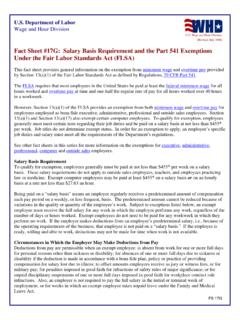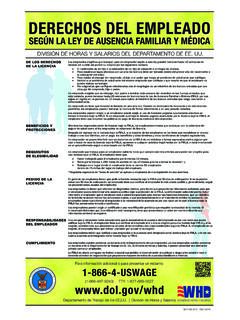Transcription of Supporting Reentry Employment and Success: A Summary …
1 Research Brief Johanna Lacoe, Mathematica and Hannah Betesh, Social Policy Research Associates Supporting Reentry Employment and success : A Summary of the Evidence for Adults and Young Adults Employment is a potential source of stability and opportunity for Americans trying to better their lives after involvement with the criminal justice system. The path to Employment can be difficult for Key Findings this population, however, and the challenges differ This brief reviews research on Employment , depending on age. Adults often enter the justice cognitive behavioral therapy (CBT), and case system with barriers to Employment and struggle management models for justice-involved adults to reconnect to the labor market after their release and young adults and finds.
2 From incarceration, due to such factors as limited Most prior studies of adult Employment Reentry basic skills and soft skills, employers' reluctance programs do not consistently show effects due to hire people with criminal records, and difficulty to variation in program models, implementa- retaining stable Employment because of unstable tion quality, and study designs. housing, lack of adequate transportation, or mental health problems. Young adults (ages 18 to 24) are Reentry programs specifically tailored to young developmentally different from adults; therefore, adults often include job training or employ- programs that improve outcomes for adults may ment support, but evidence of Employment need to be tailored to address the specific needs impacts is limited.
3 Of young adults before they show similar results. CBT interventions reduce recidivism for jus- Disruptions in education due to court involvement tice-involved adults, but impacts on young early in the lives of young adults can derail future adults and on Employment outcomes are Employment opportunities, without appropriate unknown. interventions. Both populations need support in The ongoing REO evaluation (2017-2022) has connecting to Employment after justice system the potential to provide evidence on strategies involvement. This issue brief maps the evidence to reduce recidivism and increase Employment and remaining gaps in the knowledge base on for justice-involved individuals.
4 Interventions for these groups ahead of a national evaluation of Employment -focused Reentry programs serving justice-involved adults and young adults. Reentry Employment Opportunities Evaluation Under contract from DOL, Mathematica Policy Research and Social Policy Research Associates (SPR) are conducting an evaluation of the REO grant program. The implementation and impact studies aim to build evidence about effective strategies to serve people with prior justice involvement and facilitate their successful Reentry into the community. SEPTEMBER 2019 > 1. Reentry Employment Opportunities Research Brief Reentry Employment Opportunities grants and evaluation About this brief For more than a decade, the Department of Labor This issue brief summarizes the evidence on (DOL) has invested in Reentry services by committing program models for serving justice-involved substantial funding toward programs serving jus- adults and young adults through connection tice-involved young adults and adults, under a funding to Employment , cognitive behavioral therapy, umbrella currently known as the Reentry Employment and case management services (Figure 1).
5 The Opportunities (REO) program in the Employment and primary evidence of the effectiveness of these Training Administration. Between 2015 and 2018, DOL models comes from a review of experimental awarded more than $200 million in funds under three and quasi-experimental impact evaluations. REO grant opportunities: (1) $ million in Reentry Information about factors that may contribute Project grants, (2) $31 million in Reentry Demonstra- to the successful implementation of the models tion Project grants, and (3) $21 million in Training to comes from a review of outcome evaluations and work grants.
6 This funding targets young adults (ages implementation studies. The brief closes with a 18 to 24) and adults (ages 25 and over) with previous Summary of gaps in the knowledge base and an involvement in the criminal justice system. programs assessment of the potential contributions of the funded under these grant streams serve justice-in- ongoing REO evaluation to narrowing these gaps. volved populations using one or more approaches for Employment -focused services: registered appren- ticeship, work -based learning, and career pathways. Although each of these grant programs offers differ- Recognizing the opportunity to learn from the REO.
7 Ent services, the overarching aim of the REO program initiative investments, DOL's Chief Evaluation Office is to improve Employment outcomes and workforce contracted with Mathematica Policy Research and readiness for the target population through employ- Social Policy Research Associates to build evidence ment services, case management, and other support- about what works to connect justice-involved ive services, including legal services. individuals to Employment in support of successful Reentry . The evaluation aims to identify innovative ways to provide services that will improve labor market and criminal justice system outcomes of REO Priority Employment Strategies REO participants.
8 REO grantees were required to use at least one of the following Employment strategies: registered The 118 REO projects funded between 2015 and apprenticeship, work -based learning, and career 2018 consist of 78 unique grantees; 19 were pathways. These strategies can be effective in funded under more than one grant type, and 14. helping low-income populations improve labor were funded for two projects within the same market outcomes, such as Employment and grant type. Most of these grants (88) went to earnings. Evidence includes quasi-experimental community-based organizations, which are orga- evaluations of registered apprenticeships, nizations with single sites or multiple sites within experimental evaluations of career pathways one state; the remaining 30 grants went to inter- programs , and both experimental and quasi- mediary organizations, which are organizations experimental evaluations of sector that have an affiliate network or offices in at least three communities and across at least two states.
9 Just over half of the grants (61) were for services SEPTEMBER 2019 > 2. Reentry Employment Opportunities Research Brief explicitly targeted to young adults aged 18 24. with criminal records have any reported earnings The grants predominately serve urban areas (Looney and Turner, 2018). A key goal of the REO. (105), with 1 grant serving a rural area only, and grants is to support connection to Employment for 12 grants serving a mix of urban and rural areas. justice-involved people through evidence-based Expected enrollment ranged from 72 to 705 par- models. Most prior research on Reentry Employment ticipants, with an average enrollment expectation programs focuses on models for adults, not young of 261 participants per grant across all projects.
10 Adults. This section reviews the evidence on the As discussed in more detail throughout the brief, effectiveness of these Employment -focused models many of the REO grantees plan to combine struc- for improving labor market outcomes and reducing tured Employment experiences through models recidivism among adults. It then reviews research such as apprenticeship, work -based learning, and on cognitive-behavioral therapy and wraparound career pathways with case management and services (which, although not specifically designed supportive services to facilitate the transition to to improve Employment outcomes, are common unsubsidized Employment .)













